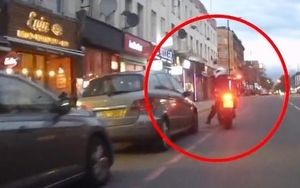On a pebbled beach in Genoa, Italy, an extraordinary sight is drawing the attention of curious onlookers. A sleek, black robot dog wanders purposefully, each step punctuated by the sound of an integrated vacuum system sucking up cigarette butts scattered on the ground. This remarkable machine, named VERO (Vacuum-cleaner Equipped Robot), is the latest innovation from the Dynamic Legged Systems lab at the Italian Institute of Technology (IIT).
VERO’s development is a response to a pressing environmental issue. Cigarette butts are the second most common type of litter on the planet. According to estimates, over 4 trillion of the roughly 6 trillion cigarettes smoked annually are discarded irresponsibly. These residual butts contain more than 700 toxic chemicals, posing significant threats to ecosystems and contributing to pollution in coastal and urban areas alike.
The team at IIT, led by researcher Claudio Semini, embarked on an ambitious project to tackle this ubiquitous problem with advanced robotics. Built on the Unitree’s AlienGo platform, the $50,000 robot is equipped with a commercial vacuum cleaner mounted on its back. Custom 3D-printed nozzles are affixed to hoses that run from the vacuum down each leg, enabling the robot to collect cigarette butts efficiently without hindering its movement.
While the concept of a quadruped robot is not new, VERO stands out due to its dual functionality. Each of its legs serves as both a mode of locomotion and a tool to perform additional tasks, a feature not commonly seen in legged robots. This dual-use functionality is a milestone in robotic engineering. Instead of merely repurposing its legs temporarily, VERO continues to use them for walking while simultaneously cleaning the ground.
VERO’s operational efficiency is made possible by a convolutional neural network and visual-servoing system. These technologies allow the robot to identify and zero in on litter. Upon detecting a cigarette butt, VERO activates the nearest vacuum nozzle and precisely maneuvers its foot over the trash. The visual-servoing technique utilizes feedback from a vision sensor, ensuring accurate and efficient clean-up.
The robot’s efficiency was tested in six diverse outdoor scenarios. These trials demonstrated that VERO could autonomously collect nearly 90% of cigarette butts, a figure that likely surpasses human clean-up efforts, as constant manual labor often leads to fatigue. Moreover, the robot can operate continuously as long as its batteries hold, making endurance a significant advantage over human workers.
The VERO prototype’s ability to navigate and clean various terrains, from beaches to narrow alleyways, highlights its versatility. The innovative design also has broader implications. The team at IIT suggests potential applications in agriculture, construction, and infrastructure maintenance. For instance, the robot could be fitted with attachments for tasks such as spraying weeds, inspecting structural cracks, or even driving nails and rivets. This adaptability could revolutionize smart robotics across multiple industries.
While the initial focus of VERO is on litter removal, the variety of potential uses for this technology is staggering. Imagine a single robot, equipped with different tools on each foot, systematically performing various tasks in an environment without human intervention. Such advancements could significantly reduce manual labor and usher in a new era of automation.
Despite some early criticisms about its speed and the practicality of multiple vacuum nozzles, VERO’s development represents a promising step forward. The team is already considering modifications and improvements to enhance the robot’s performance. One such consideration is using the robot for tasks beyond vacuuming, which might make it a staple tool in various fields, achieving tasks that are currently cumbersome for robotic platforms.
VERO’s journey from a conceptual model to a functional prototype required rigorous testing and innovative problem-solving. The researchers had to overcome challenges related to the robot’s stability, suction efficiency, and environmental adaptability. For example, while operating on sandy beaches, the team had to ensure that the robot’s suction mechanism could differentiate between actual litter and harmless debris like sand.
In an early test, the robot had to navigate a cluttered urban environment, an apt simulation of real-world conditions. It managed to identify and collect cigarette butts successfully, proving that it could handle the complexities of varied terrain. These successful trials offered a glimpse into the robot’s potential for real-world application.
The sight of VERO gracefully navigating and cleaning a beach in Genoa is more than just a technological marvel; it’s a beacon of hope for environmental conservation efforts. The invention underscores the importance of innovative solutions in addressing long-standing ecological problems. As Semini points out, the ultimate goal is not just to clean up but to pave the way for smarter, more efficient environmental stewardship.
Although VERO is still in its prototype phase, its development could inspire similar projects worldwide. As technology continues to evolve, so too will our ability to tackle waste management and environmental cleanup challenges. With robots like VERO leading the charge, we might very well see a future where autonomous machines play a crucial role in preserving our planet.
As Evan Ackerman, a senior robotics editor at IEEE Spectrum, notes, “This is about a lot more than cigarette butts.” It’s about redefining what robots can do and how they can augment human efforts in maintaining our environment. VERO's potential far extends beyond waste collection, embodying a future where robots might be omnipresent allies in various sectors, working tirelessly to ensure cleaner, safer, and more efficient systems.



